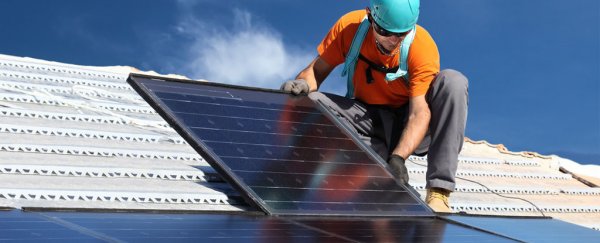When it comes to personally investing in green energy, installing solar panels on your roof is one of the more practical options available to us regular people. Wind turbines and hydro power stations are awesome, but they're not something the average suburban or metropolitan consumer really has much to do with up close. Solar technology, on the other hand, is much more personally accessible.
But how much of a contribution can solar really make to the electricity grid? According to a new analysis by the US Department of Energy, it's a pretty big chunk. If all of the available roof space that could be practically fitted with solar panels were maxed out, it could make up the equivalent of 39 percent of the nation's electricity.
This amount, which adds up to a technical potential of 1,118 gigawatts (GW) of capacity and 1,432 terawatt-hours (TWh) of annual energy generation, could take a large burden off our reliance on fossil-fuel-based power – but obviously, it'd be a massive undertaking to fit out all that available roof space.
To come up with the estimate, scientists from the National Renewable Energy Laboratory (NREL) used light detection and ranging ( LiDAR) data to calculate the suitability of rooftops for hosting solar panels – aka rooftop photovoltaic (PV) systems – in 128 cities across the US, then extrapolated from there.
Within the cities examined, the researchers found 83 percent of small buildings have a suitable location for installation of solar panels. But when they analysed each building's capacity to hold a PV system on their roof, only 26 percent passed the grade.
While only about a quarter of most small buildings' roofs could practically be used for solar panels, there are a whole lot of them across the US, which means this type of building could actually provide the greatest combined technical potential compared to other kinds of structures.
The upshot is that people's houses could make the biggest contribution to solar power generation, with all small buildings in the US combined accounting for about two-thirds of the country's total rooftop technical potential. Medium and large buildings combined would make up the other third.
But the scientists say we could even go beyond this, because obviously the combined rooftop area across the nation, while massive, is surrounded by all kinds of other potential solar-absorbing spaces and surfaces.
"It is important to note that this report only estimates the potential from existing, suitable rooftops, and does not consider the immense potential of ground-mounted PV," said NREL senior energy analyst Robert Margolis. "Actual generation from PV in urban areas could exceed these estimates by installing systems on less suitable roof space, by mounting PV on canopies over open spaces such as parking lots, or by integrating PV into building facades."
If you want to find out about the potential energy generation your house's roof could provide, and learn more about the kinds of costs involved in installing a solar system, check out Google's Project Sunroof, which figures out how much solar energy is hitting your rooftop based on satellite imagery.
Awesome.
